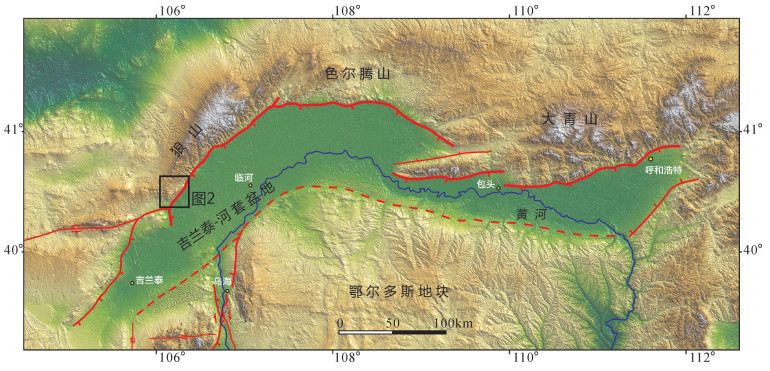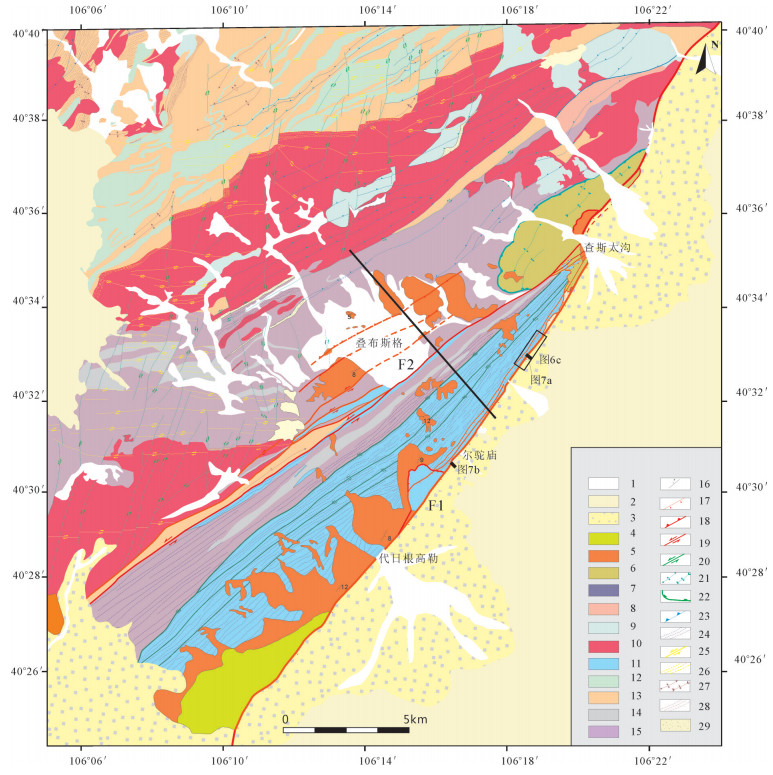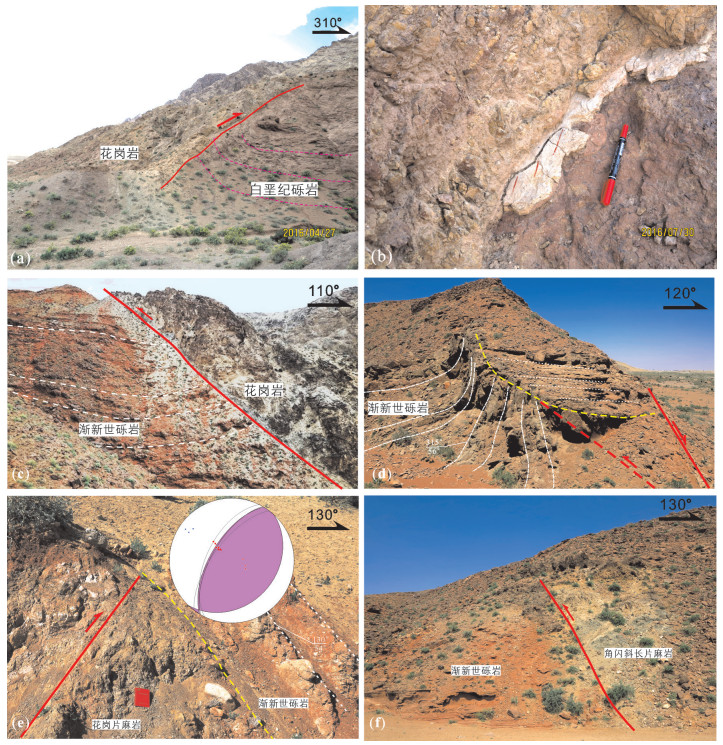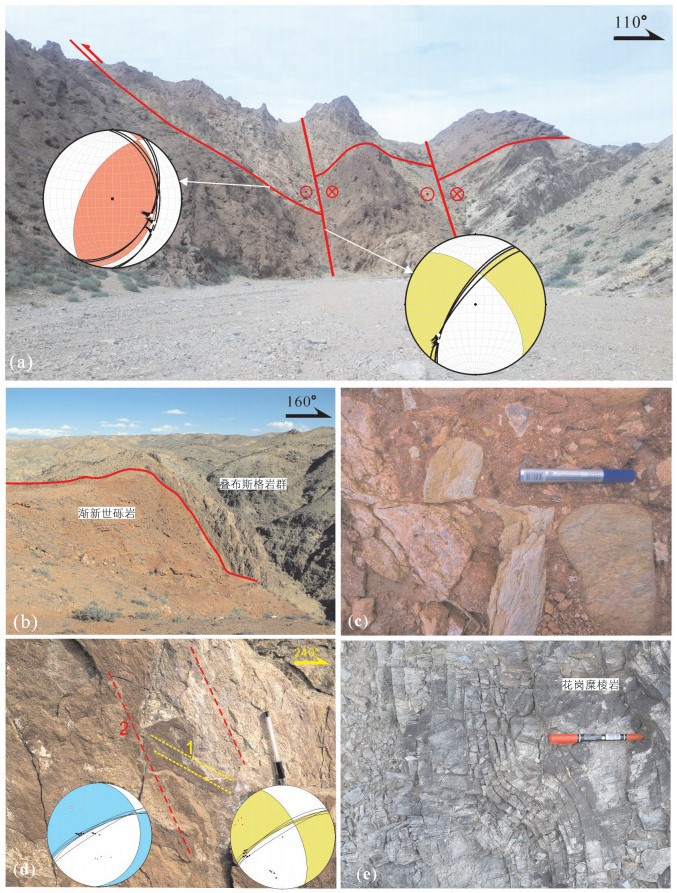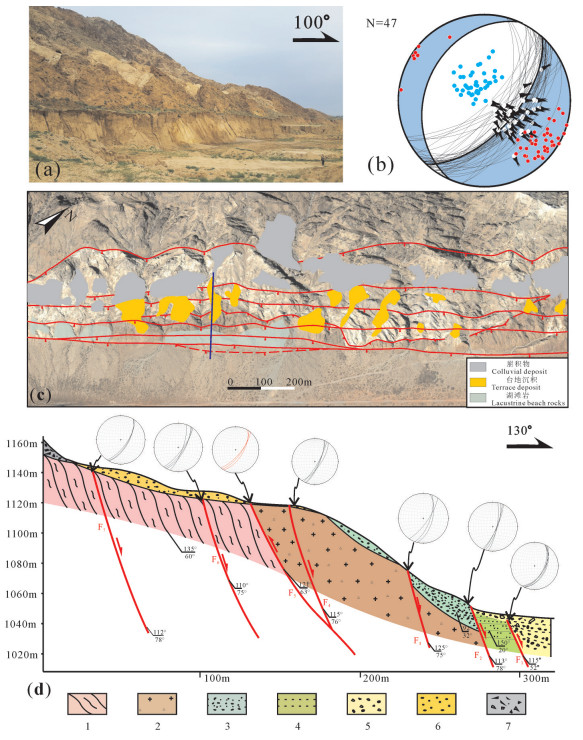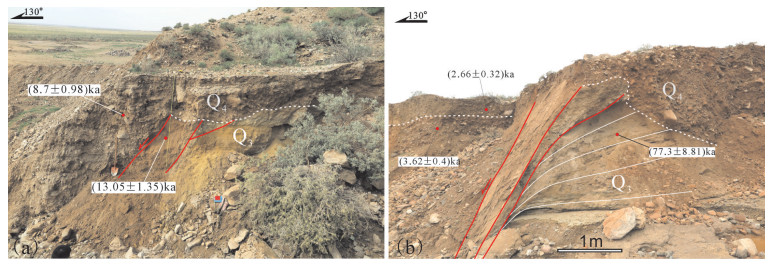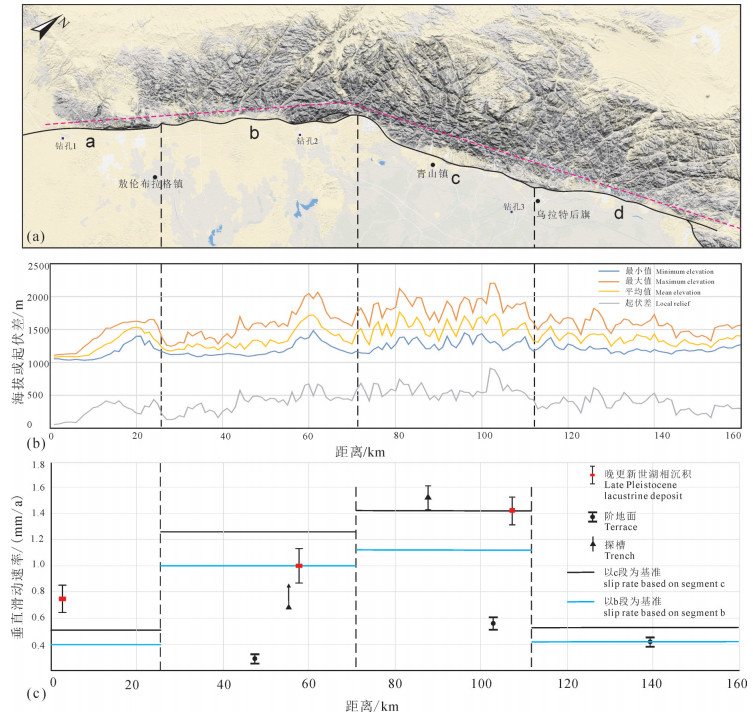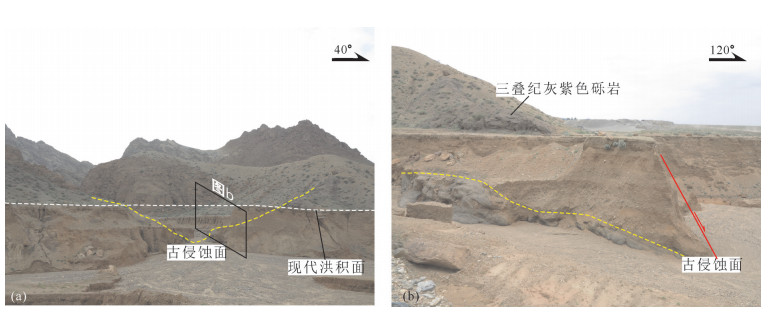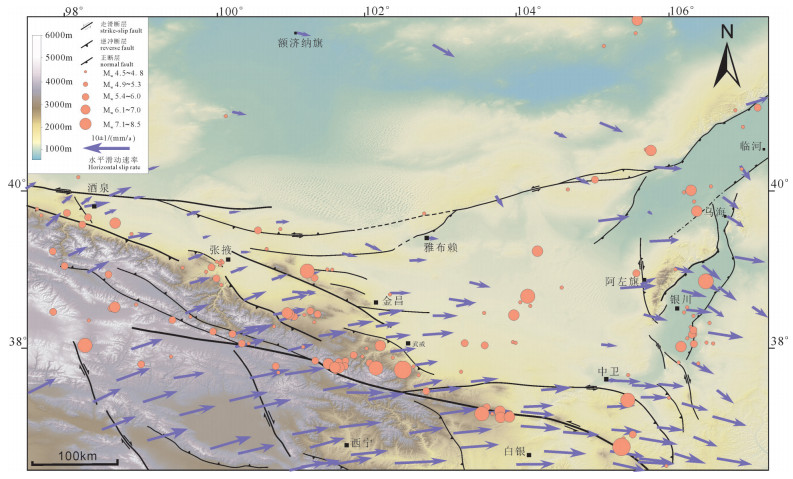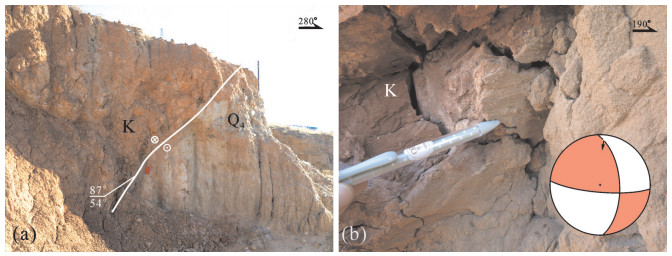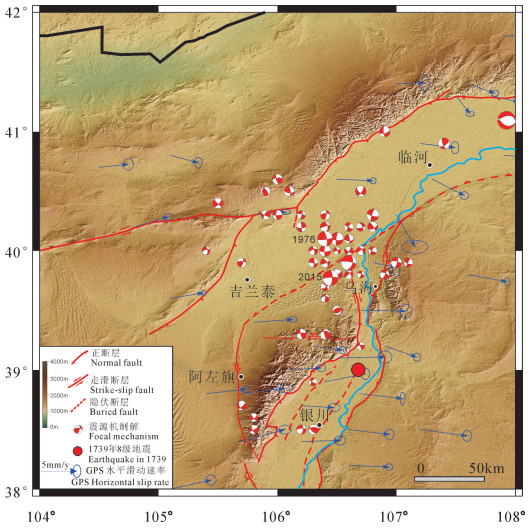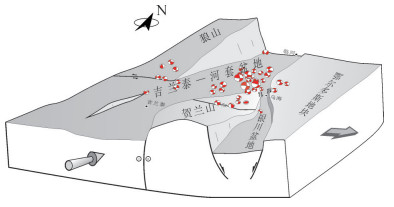Characteristics of Cenozoic faults in Langshan area, Inner Mongolia: Constraint on the development of normal faults
-
摘要:
阿拉善地块东北缘的狼山地区新生代发育有3期构造,分别为中新世NW-SE向挤压形成的逆断层,NNE向挤压形成的左行走滑断层以及晚新生代NW-SE向伸展形成的高角度正断层。结合阿拉善地块东缘的新生代构造,认为狼山地区新生代断层的活动与青藏高原东北缘的逐步扩展、应力场逐渐调整有关。狼山山前正断层目前是一条贯通的断层,其演化基本符合恒定长度断层生长模型,断层中间部位滑动速率最大,向断层两侧逐渐递减。从不同方法得出的滑动速率来看,进入全新世以来,断层滑动速率有逐渐变小的趋势。结合阿拉善地块内部及东缘断层震源机制解以及断层的几何学、运动学特征,认为河套—吉兰泰盆地和银川盆地属于两个性质不同的伸展盆地,两者通过构造转换带相连,转换区内断层表现为右行走滑。转换区5级以上地震可能是受区域性NE-SW向挤压,近南北向右行断层活动的表现。
Abstract:The Langshan area, located on the northeastern margin of the Alxa block, was subjected to 3 deformation stages during the Cenozoic, which produced thrust faults formed by NW-SE compression in the late Miocene, left-lateral strike-slip faults caused by NNE compression and active normal faults in the late Cenozoic. Based on peripheral Cenozoic structures around the eastern Alxa margin, the authors infer that these Cenozoic faults were related to the gradual propagation of northeast Tibetan Plateau and the readjustment of the stress field. The Langshan piedmont fault zone is now at a stage of linkup, which is compatible with the constant-length fault model with the highest slip rate in the central part. The slip rate from Holocene seems to tend to become lower relative to the slip rate since late Pleistocene. Combined with the focal mechanisms as well as geometries and kinematics of faults in and around the Alxa block, the authors tentatively propose that the Hetao-Jilantai basin and the Yinchuan basin are two different extensional basins linked by a transfer zone, in which nearly NNE-trending dextral faults are developed. The Mw >5 earthquakes within the transfer zone probably occurred on the steep dextral faults as the result of regional SW-NE compression.
-
Keywords:
- Langshan /
- normal faults /
- fault growth /
- Alxa /
- Tibetan Plateau /
- geological survey engineering
-
走滑断裂是沉积盆地中特殊而且力学机制复杂的断裂系统,走滑断裂及其破碎带本身是重要的储油气空间,同时,高角度的走滑断裂常常沟通地层深部流体,是油气运聚的输导体系,对储层的形成与油气的分布具有重要的控制作用。近期针对大型走滑断裂及其破碎带的直接钻探在塔里木盆地奥陶系层间岩溶区的塔中I号气田、哈拉哈塘油田和轮古东气田均取得了预期效果[1-4],极大地拓展了油气勘探开发领域,也使得对塔里木盆地走滑断裂的研究与认识更进一步深化。一方面加强走滑断裂的识别、构造样式的刻画及力学机制的研究[1-7];另一方面对走滑断裂破碎带结构的研究引起关注,张庆莲等[8],潘文庆等[9]对塔里木盆地西北缘的柯坪—巴楚露头区野外裂缝地质建模明确走滑断裂控制的裂缝发育带具有明显的分带性,距断层由近及远可细分为“破碎带、劈理带、菱形裂缝带、稀疏裂缝带”;邬光辉等[10]通过野外与井下地质建模,指出塔里木盆地奥陶系沿走滑断裂带走向上断裂相具有分段性和差异性,可定性分为高渗透相和致密相区;孙东等[11]通过地震储层正演明确断层面及断裂破碎带能产生串珠状反射。这些研究成果对认识走滑断裂破碎带在三维空间复杂结构及解译其与油气富集规律提供了新的思路和方法。
前期针对轮古东气田断裂系统的研究,由于受地震资料品质和勘探开发程度的限制,对走滑断裂的解释有待深入,对断裂破碎带及伴生裂缝发育特征研究较少[4],本文以最新处理完成的轮古东300 km2叠前深度偏移地震资料为基础,结合区域已有钻井资料综合分析轮古东气田走滑断裂的识别、发育特征、断裂破碎带的组合方式以及控储控藏特征,以期为该区进一步勘探开发提供指导。
1. 地质背景
轮古东气田地处新疆轮台县境内,构造上隶属于塔里木盆地塔北隆起轮南低凸起中部。奥陶纪地层发育齐全,可细分为上奥陶统桑塔木组、良里塔格组和吐木休克组(又称恰尔巴克组)、中奥陶统一间房组及中下奥陶统鹰山组和蓬莱坝组。
主要勘探目的层为一间房组和鹰山组,其次为良里塔格组,一间房组埋藏深度5050~6700 m,厚度10.5~42 m,发育台缘和台内丘滩复合体沉积,岩性以浅褐灰-灰褐色亮晶砂屑灰岩、亮晶鲕粒灰岩和亮晶藻屑砂屑灰岩为主,在AG35、AG621等井都发现托盘类生物礁。鹰山组自上而下可细分为4段:鹰一段(O1-2y1)、鹰二段(O1-2y2)、鹰三段(O1-2y3)和鹰四段(O1-2y4),本区绝大多数钻井仅钻揭鹰一段,主要发育亮晶砂屑灰岩、泥晶灰岩,为开阔台地相的台内滩和滩间海沉积。
研究区东邻草湖生油凹陷,南接满加尔生油坳陷,位于油气运移主要方向的前沿部位,构造位置十分有利。以近南北向轮东I号走滑断裂带为界,构造西缓东陡,总体为一东南倾大型斜坡(图 1),一间房组顶面构造高差1650 m,奥陶系油气主力产层一间房组在西北部受剥蚀而尖灭。储层以裂缝孔洞型储层为主,发育少量洞穴型储层,整体表现为受断裂和沉积相带分割,局部断块含少量边、底水的大型准层状凝析气藏[12-13]。
2. 断裂与裂缝特征
2.1 地震资料断裂识别
平剖结合,多方法开展工区断裂解释,小断层产状较陡,主要根据上下地层即寒武系和良里塔格顶面存在断距和挠曲,以及地震同相轴存在变化进行识别[3]。在此基础上,通过沿层切片、相干属性等技术实现断裂与裂缝的平面识别,以垂直剖面为主精细解释断层。
2.1.1 断裂平面识别
相干体技术是一种不连续的检测手段,当地下有断层、裂缝或地质异常体(如洞穴、河道、串珠等)时,地层产生横向不均匀现象,相邻地震道之间的反射波在振幅、频率及相位等方面都将发生不同程度的变化,进而达到检测断层、反映岩性异常体的目的,相干体切片比常规切片能更好地表现断层和沉积特征。从沿层相干切片结果分析,中深层断裂平面上主要分4组:走滑断层主要呈近南北、北东和北西向3组断裂,且北东向断层错断北西向断层;逆冲断裂为近东西走向,主要位于工区西部(图 2~图 3)。石炭系以上以雁列式走滑断层和逆冲断裂为主,走滑断层主要发育近南北向以及两条近北东向断裂(图 4)。
2.1.2 断裂剖面识别
根据区域构造运动背景以及断层平剖面特征,研究区断裂可划分为3期4组。中晚加里东期走滑断裂、晚海西期逆冲断裂以及喜山期走滑断裂(图 1、图 5)。
早加里东期寒武系—中下奥陶统,塔北隆起稳定沉积,无大的构造活动,断裂不发育,沉积大套灰岩地层。中晚加里东期断裂开始活动,沉积地层由碳酸盐岩向碎屑岩过渡,发育近北西和北东向走滑断层,延伸距离约10~25 km,剖面上,断裂近乎陡直,向下断入震旦系,向上消失于奥陶系桑塔木组,断距一般小于100 m(图 5-c)。该期断层是晚加里东期寒武系—下奥陶统烃源岩的原油充注的主要通道,沿断层分布形成古油藏。
晚海西期受区域性南北向挤压应力作用,工区西部发育两条近东西走向的逆冲断裂(桑塔木南断裂和桑塔木北断裂),剖面上呈“y”字形特征,其中桑塔木北断裂是一条主断裂,东西延伸约18 km,断距大,垂向断距最大达200 m,断开层位多,上至三叠系底,下至寒武系、震旦系;桑塔木南断裂是桑塔木北断裂的一条大的伴生断裂,断开层位少,上部仅断开石炭系,下部消失在奥陶纪地层中,垂向断距最大达150 m(图 5-a)。桑塔木断裂控制了局部构造形态,构造脊部裂缝发育,井间连通性好。根据挤压应力的剪切分量分析,推测该时期南北向轮东1号走滑断裂已开始发育,整体表现为压扭性特征。
喜山期受张剪应力作用,贯穿工区的南北向轮东1号走滑断裂进一步活动,表现为右旋走滑特征,并伴生一些列北东-南西向次级走滑断裂,控制工区构造格局,轮东1号断裂区内延伸21.8 km,断开层位从基底至侏罗系,断距20~100 m。石炭系以下表现为压扭性质,在工区AG35和AG35-1井附近表现最为明显,奥陶系断面倾向多变,工区南部东倾,中部西倾,北部东倾,具有典型丝带状效应;同时平面上断层两盘高低关系一直在变化,具有明显海豚效应(图 5-b)。石炭系及以上地层剖面上表现为负花状构造,断层性质由压扭转化为张扭性质,呈明显负反转构造,平面上表现为雁列式右旋走滑特征。轮东I号断裂是喜山期寒武系原油裂解气的主要充注通道,沿断裂走向裂缝发育,天然气富集。
2.2 岩心薄片裂缝特征
由于碳酸盐岩储层强非均质性,储层发育井段往往发生漏失,取心困难,岩心分析仅代表基质物性[1]。研究区岩心常规物性分析孔隙度样品1259块,渗透率样品963块,平均孔隙度1.615%,平均渗透率2.82×10-3μm2。基质孔隙度差,次生的溶蚀孔、洞和裂缝是主要的储集空间,裂缝既是储集空间,又是渗滤通道。研究区9口井428.89 m岩心统计,共发育裂缝965条,其中未充填和半充填缝649条,占裂缝总数的67.3%,以倾角 > 75°的高角度缝为主,缝密度1.22条/m(图 6~图 7)。
![]() 图 6 轮古东气田奥陶系碳酸盐岩岩心照片a—AF127井,5569.8 m,O1-2y,泥晶灰岩,高角度构造缝,缝宽2~4 mm,沿缝部分充填方解石;b—AN631井,5791.5 m,O3t,亮晶生屑灰岩,二组构造缝斜交,沿裂缝溶蚀和充填,缝面见氧化边;c—AN62井,5782.3 m,O1-2y,颗粒灰岩,晚期水平裂缝切割早期缝合线,沿晚期裂缝部分溶蚀;d—AG392井,6264.5 m,O2y,藻粘结砂砾屑灰岩,高角度构造缝,半充填方解石,岩心上见构造缝不连续延伸;e—AN621井,5766.2 m,O3t,颗粒灰岩,早期缝合线被晚期高角度构造缝切割,半充填泥质;f—AG35井,6158.4 m,O3t,砂屑生屑灰岩,早期溶洞充填角砾与巨晶方解石,晚期裂缝切割早期裂缝,沿晚期裂缝扩溶;g—AN631井,5973.1 m,O1-2y,早期网状裂缝呈龟背状充填方解石,晚期沿部分宽缝充填泥质,岩心部分大理岩化;h—AG391井,5817.2 m,O3l,生物砾屑灰岩,生物为珊瑚和藻类,为洞穴充填角砾,砾间充填泥质;i-AG392井,6345.7 m,O1-2y,亮晶颗粒灰岩,缝合线发育Figure 6. Core photos of Ordovician carbonate rock in Lungudong gas fielda-Well AF127, 5569.8 m, O1-2y, cryptite, high angle structural fracture, width of fracture 2-4 m, partly filled with calcite along fractures; b-Well AN631, 5791.5 m, O3t, calcsparite bioclastic limestone, two groups of structural fractures obliquely crossing, corroded and filled along fractures, oxidation edge distributed in fracture panel; c-Well AN62, 5782.3 m, O1-2y, grained limestone, late period horizontal fractures cutting early stage furrow lines, partly corroded along late period fractures; d-Well AG392, 6264.5 m, O2y, algal bound gritty limestone, high angle structural fracture, half filled with calcite, structural fractures discontinuously extending in core; e-Well AN621, 5766.2 m, O3t, grained limestone, late period high angle structural fractures cuting early stage furrow lines, half filled with shale; f-Well AG35, 6158.4 m, O3t, gritty bioclastic limestone, early period limestone cave filled with rubble giant crystal calcite, late period fractures cutting early period fractures. corroded along late period fractures; g-Well AN631, 5973.1 m, O1-2y, early period calcite filling fractures like turtleback, late period part of broad fractures filled with shale, core partly marbleized; h-Well AG391, 5817.2 m, O3l, bioclastic calcirudite, bioclasts consisting of coral and algae, cave filled with rubble stone, shale filling inter gravel; i-Well AG392, 6345.7 m, O1-2y, calcsparite grained limestone, developing furrow lines
图 6 轮古东气田奥陶系碳酸盐岩岩心照片a—AF127井,5569.8 m,O1-2y,泥晶灰岩,高角度构造缝,缝宽2~4 mm,沿缝部分充填方解石;b—AN631井,5791.5 m,O3t,亮晶生屑灰岩,二组构造缝斜交,沿裂缝溶蚀和充填,缝面见氧化边;c—AN62井,5782.3 m,O1-2y,颗粒灰岩,晚期水平裂缝切割早期缝合线,沿晚期裂缝部分溶蚀;d—AG392井,6264.5 m,O2y,藻粘结砂砾屑灰岩,高角度构造缝,半充填方解石,岩心上见构造缝不连续延伸;e—AN621井,5766.2 m,O3t,颗粒灰岩,早期缝合线被晚期高角度构造缝切割,半充填泥质;f—AG35井,6158.4 m,O3t,砂屑生屑灰岩,早期溶洞充填角砾与巨晶方解石,晚期裂缝切割早期裂缝,沿晚期裂缝扩溶;g—AN631井,5973.1 m,O1-2y,早期网状裂缝呈龟背状充填方解石,晚期沿部分宽缝充填泥质,岩心部分大理岩化;h—AG391井,5817.2 m,O3l,生物砾屑灰岩,生物为珊瑚和藻类,为洞穴充填角砾,砾间充填泥质;i-AG392井,6345.7 m,O1-2y,亮晶颗粒灰岩,缝合线发育Figure 6. Core photos of Ordovician carbonate rock in Lungudong gas fielda-Well AF127, 5569.8 m, O1-2y, cryptite, high angle structural fracture, width of fracture 2-4 m, partly filled with calcite along fractures; b-Well AN631, 5791.5 m, O3t, calcsparite bioclastic limestone, two groups of structural fractures obliquely crossing, corroded and filled along fractures, oxidation edge distributed in fracture panel; c-Well AN62, 5782.3 m, O1-2y, grained limestone, late period horizontal fractures cutting early stage furrow lines, partly corroded along late period fractures; d-Well AG392, 6264.5 m, O2y, algal bound gritty limestone, high angle structural fracture, half filled with calcite, structural fractures discontinuously extending in core; e-Well AN621, 5766.2 m, O3t, grained limestone, late period high angle structural fractures cuting early stage furrow lines, half filled with shale; f-Well AG35, 6158.4 m, O3t, gritty bioclastic limestone, early period limestone cave filled with rubble giant crystal calcite, late period fractures cutting early period fractures. corroded along late period fractures; g-Well AN631, 5973.1 m, O1-2y, early period calcite filling fractures like turtleback, late period part of broad fractures filled with shale, core partly marbleized; h-Well AG391, 5817.2 m, O3l, bioclastic calcirudite, bioclasts consisting of coral and algae, cave filled with rubble stone, shale filling inter gravel; i-Well AG392, 6345.7 m, O1-2y, calcsparite grained limestone, developing furrow lines![]() 图 7 轮古东气田奥陶系碳酸盐岩储层铸体薄片a—AN48井,5548.5 m,O2y,泥粉晶灰岩,构造缝交织分布,沿缝见扩溶现象,红色铸体;b—AN621井,5778.3 m,O1—2y,亮晶颗粒灰岩,压溶和溶蚀缝,红色铸体;c—AN14井,5335.6 m,O3l,泥粉晶灰岩,构造缝交织分布,红色铸体;d—AG18井,5540.2 m,O2y,粉晶灰岩,构造缝交织分布,红色铸体;e—AG39井,5832.5 m,O2y,泥—亮晶颗粒灰岩,沿构造缝扩溶后,部分方解石充填,红色铸体;f—AG391井,5810.1 m,O3l,泥—亮晶颗粒灰岩,压溶缝,红色铸体Figure 7. Cast slice of Ordovician carbonate reservoir in Lungudong gas fielda-Well AN48, 5548.5 m, O2y, powder micrite limestone, structural fractures interleave, expanded corrosion along fractures, red cast; b-Well AN621, 5778.3 m, O1–2y, calcsparite grained limestone, pre-solution and corroded fractures, red cast; c-Well AN14, 5335.6 m, O3l, powder micrite limestone, structural fractures interleave, red cast; d-Well AG18, 5540.2 m, O2y, crystal powder limestone, structural fractures interleave, red cast; e-Well AG39, 5832.5 m, O2y, micrite-calcsparite grained limestone, after expanding corrosion along fractures, partly filled with calcite, red cast; f-Well AG391, 5810.1 m, O3l, micrite-calcsparite grained limestone, pre-solved fractures, red cast
图 7 轮古东气田奥陶系碳酸盐岩储层铸体薄片a—AN48井,5548.5 m,O2y,泥粉晶灰岩,构造缝交织分布,沿缝见扩溶现象,红色铸体;b—AN621井,5778.3 m,O1—2y,亮晶颗粒灰岩,压溶和溶蚀缝,红色铸体;c—AN14井,5335.6 m,O3l,泥粉晶灰岩,构造缝交织分布,红色铸体;d—AG18井,5540.2 m,O2y,粉晶灰岩,构造缝交织分布,红色铸体;e—AG39井,5832.5 m,O2y,泥—亮晶颗粒灰岩,沿构造缝扩溶后,部分方解石充填,红色铸体;f—AG391井,5810.1 m,O3l,泥—亮晶颗粒灰岩,压溶缝,红色铸体Figure 7. Cast slice of Ordovician carbonate reservoir in Lungudong gas fielda-Well AN48, 5548.5 m, O2y, powder micrite limestone, structural fractures interleave, expanded corrosion along fractures, red cast; b-Well AN621, 5778.3 m, O1–2y, calcsparite grained limestone, pre-solution and corroded fractures, red cast; c-Well AN14, 5335.6 m, O3l, powder micrite limestone, structural fractures interleave, red cast; d-Well AG18, 5540.2 m, O2y, crystal powder limestone, structural fractures interleave, red cast; e-Well AG39, 5832.5 m, O2y, micrite-calcsparite grained limestone, after expanding corrosion along fractures, partly filled with calcite, red cast; f-Well AG391, 5810.1 m, O3l, micrite-calcsparite grained limestone, pre-solved fractures, red cast根据形成机理,裂缝分为构造缝、压溶缝和溶蚀缝。构造缝约占区内裂缝总数的60%,缝宽一般小于5 mm,主要为剪切缝,其次为张性缝。构造缝以垂直缝最为发育,早期构造缝平行排列,局部呈枝叉状和雁行状,多数已被方解石、泥质和沥青质全充填或半充填,局部区域多期不同产状的裂缝相互交切形成网状裂缝。压溶缝是由沉积负荷引起的压实作用和压溶作用形成,主要表现为缝合线,产状多与层面平行,呈锯齿状和肠状弯曲延伸,常被泥、铁质半充填或全充填,约占裂缝总数的20%。溶蚀缝主要由地表水和地下水沿早期的裂缝系统溶蚀扩大产生,呈弯曲分布,延伸短,缝宽一般 > 1 mm,沿断裂面上生长晶形完好的方解石晶体或晶簇,约占裂缝总数的15%(图 6~图 7)。
2.3 成像测井裂缝特征
成像测井是识别井周裂缝发育条数、产状和有效性等的直接手段。构造缝形成后,在后期应力和溶蚀改造下,会不断改变赋存状态,其中多期应力的改造作用目前测井技术不能有效识别,后期溶蚀作用造成的裂缝形态变化则能较好地从井壁图像上识别并确定[14-15]。
利用工区完钻32口井的成像测井资料,成像测井可识别的裂缝主要为构造缝、溶蚀缝和钻井诱导缝。构造缝主要为构造应力成因,裂缝形态完整,轨迹闭合;溶蚀缝由后期扩溶作用形成,缝面基本闭合,多不完整,呈不规则扩溶特征;钻井诱导缝为人工裂缝,由钻具机械诱导和地层应力释放造成,多为无效裂缝(图 8)。
![]() 图 8 轮古东气田奥陶系碳酸盐岩测井裂缝发育特征a、b、c、d—高角度构造窄裂缝,缝面形态基本完整,轨迹闭合;e、f、g、h—高角度构造窄裂缝,沿缝不规则扩溶;i、j、k、l—斜交羽状诱导微裂缝Figure 8. Ordovician carbonate logging fracture development characteristics in Lungudong gas fielda, b, c, d-High angle structural narrow fracture, fracture plane form is mostly intact, track closed; e, f, g, h-High angle structural narrow fracture, irregular broaden corrosion; i, j, k, l-Obliquely crossing pinnate lead tiny fracture
图 8 轮古东气田奥陶系碳酸盐岩测井裂缝发育特征a、b、c、d—高角度构造窄裂缝,缝面形态基本完整,轨迹闭合;e、f、g、h—高角度构造窄裂缝,沿缝不规则扩溶;i、j、k、l—斜交羽状诱导微裂缝Figure 8. Ordovician carbonate logging fracture development characteristics in Lungudong gas fielda, b, c, d-High angle structural narrow fracture, fracture plane form is mostly intact, track closed; e, f, g, h-High angle structural narrow fracture, irregular broaden corrosion; i, j, k, l-Obliquely crossing pinnate lead tiny fracture平面上,工区裂缝以高角度(45°~75°)裂缝为主,走向以NE-SW为主。有效裂缝具有更强的岩石切割破坏能力,裂缝宽度和密度越大,取心收获率越低,裂缝有效性越好。纵向上,良里塔格组裂缝发育受岩性控制,裂缝发育密度与自然伽马值(泥质-泥灰质含量)成反比,自然伽马值增大,泥质-泥灰质含量增高,裂缝发育密度降低,良里塔格组内部自然伽马值从约11 API变化到60 API以上,泥质-泥灰质含量从5%上升至40%以上,当自然伽马值达到45 API,泥质-泥灰质含量超过30%时,裂缝不发育。良里塔格组裂缝平均4条/100 m,以不规则网状交切微细裂缝为主要特征,裂缝开度较小,少见大开度(窄缝以上)的构造缝,平均缝宽26.9μm,中缝及宽缝(石油行业标准SY/T 6286-1997)发育率6.9%。一间房和鹰山组岩性较纯,自然伽马值普遍低于25 API,平均约16.8 API,层组内泥质-泥灰质含量没有明显变化,泥质含量平均约2.3%。裂缝发育主要受断裂(应力强度)及构造控制,岩性控制不明显,裂缝发育程度高,开度相对较大,缝面溶蚀特征明显,一间房组14条/100 m,平均缝宽44.5μm,中缝及宽缝发育率9.1%;鹰山组6条/ 100 m,平均宽度37.5μm,中缝及宽缝发育率9.8%。
2.4 地震预测裂缝特征
裂缝的存在会造成地震波频率随方位角变化,在裂缝的法线方向,频率随方位角的衰减不同于裂缝的走向方向,地震波的衰减强度与裂缝的密度成正比,裂缝越发育,频率随方位角变化就越明显,频率椭圆扁率的大小代表了频率的各向异性强度,并且用这种强度来指示裂缝发育的强度。为得到准确的裂缝密度信息,多井结合约束裂缝密度发育门槛,利用研究区取心和成像测井对裂缝发育井和不发育井共同约束,得到最终的裂缝预测数据体并进行裂缝平面预测(图 9)。
研究区一间房组裂缝最发育,利用成像测井资料约束,FRS叠前裂缝预测表明,现今最大水平主应力方向、裂缝走向、裂缝分布范围及发育密度主要受断裂控制。
现今最大水平主应力方向指示地层岩石所承受的最大应力方向,在同样的地层岩性、相似岩石机械强度条件下,走向平行于最大水平主应力方向的裂缝系统在力学上最容易保存,与之相交或垂直的裂缝则趋于闭合。轮古东气田成像测井解释仅AN171、AG38C井周边由于应力的复杂,裂缝走向与主应力走向存在较大夹角,其余区域裂缝走向与主应力走向基本一致,裂缝走向以NE-SW向为主,指示轮古东斜坡断裂系统更容易保持开启,也更容易获得高产。不同期次、走向的断裂控制的裂缝走向略有差异,南北向轮古东I号走滑断裂周边井裂缝走向主要为NE 30°~50°;北东向走滑断裂周边井裂缝走向主要为NE 30°~80°。
平面上,裂缝主要分布在断裂周围1 km范围内,成像测井及FRS叠前裂缝预测表明,随着井点距断裂距离增大,裂缝发育强度(裂缝线密度)呈指数降低,当井点距断裂距离 < 0.25 km,裂缝发育密度快速增加,当井点距断裂距离 > 1 km,裂缝发育差或不发育(图 9,图 10),与塔里木盆地西北缘柯坪—巴楚露头区多条走滑断裂的调查结论类似,即随着距断裂距离的增大,断裂控制的裂缝密度与距断裂距离呈指数递减关系[8-9]。
3. 断裂破碎带结构及与油气关系
3.1 断裂破碎带结构
走滑断裂构造样式,一般由一系列产状陡倾的大型-巨型平移断层及其间的断夹块体组成,平面上表现为雁列式、斜列式或帚状构造样式,在剖面上表现为陡立的断层带或断夹块的相间排列[16-19]。由于力学机制复杂,走滑断裂构造样式的差异造成走滑断裂破碎带在三维空间具有复杂的结构,对断裂破碎带组合方式的刻画对储层与油气运聚关系密切[8-11, 16-19]。针对研究区气藏特征,以主干走滑断裂为主线,以次级和微断裂为骨架,以裂缝为脉络,将研究区断裂破碎带平面上划分为“羽状破碎带、转换破碎带、斜列破碎带、复合破碎带”4种组合模式(图 11)。
“羽状破碎带”指次级和微断裂发育,储层沿破碎带呈散开状发育,剖面上为正花状断裂,平面上次级裂缝沿主干断裂呈羽状分布。羽状破碎带为有利的储层发育区,轮古东目前AG341、AG353、AG391C等高产井钻探区域为羽状破碎带。AG391井钻探断裂下盘的羽状破碎带,取心和成像测井证实,鹰山组发育II类裂缝孔洞型储层51.5 m/8层,平均孔隙度2.83%;III类孔洞型储层13 m/1层,孔隙度1.8%。鹰山组裂缝发育,为高角度的窄缝,以构造剪切缝为主,底部存在少量的构造张性缝,且沿裂缝有扩溶作用,该井累产油0.16×104 t,累产气0.25×108 m3;AG391C井钻探临近的断裂上盘的羽状破碎带,效果要好于AG391井,目前已累产油0.55×104 t,累产气0.61×108 m3,一方面表明羽状破碎带局部构造高点油气更为富集;另一方也证实,羽状破碎带内部结构复杂,断裂上盘和下盘之间存在油气的侧向封堵。目前塔里木盆地塔中I号气田Z15井区已通过水平井穿主干断裂钻探羽状破碎带的多个串珠集合体,完钻13井取得预期效果,已建成黑油年产能25×104 t[2]。
“转换破碎带”指走滑断裂转换部位,应力从一条断层逐渐转至另一条断层,特定部位同时发育两条走滑断裂,裂缝主要发育于两断层叠置的转换破碎带内。研究区仅AG39井发育,剖面上为正花状断裂,平面上轮东1号断裂AG39构造分段转换形成局部构造,主要的构造变形层系位于中上奥陶统,石炭系地层无明显的构造变形,上奥陶统良里塔格组地层厚度没有明显变化。AG39井钻探构造高点,实钻证实储层发育,上奥陶统良里塔格组与下奥陶鹰山组均发育储层且测试均获得高产,成相测井解释储层以裂缝孔洞型储层为主,II类储层2.5 m/1层,孔隙度3%,III类储层66.5 m/7层,平均孔隙度1.63%,裂缝主要集中发育于良里塔格组表层,以构造张性缝为主,扩溶现象明显,裂缝走向为东西向,应力走向为北东向,与裂缝走向存在40°夹角。该井良里塔格试采,已累产油0.94×104 t,累产气1.32×108 m3。
“斜列破碎带”指裂缝在主干和次级断裂集中发育,储层沿走滑断裂呈线性分布,剖面上次级断裂与主干断裂近平行排列,呈近直立状,平面上次级断裂和裂缝分布于主干断裂的二侧,呈大角度斜交。目前轮古东区块仅轮古35-1钻遇该破碎带,测井解释II类储层4.5 m/1层,孔隙度2.7%;III类储层36 m/5层,平均孔隙度1.72%。由于该井井下落鱼未能投产,产能情况有待后续评价。
“复合破碎带”指走滑断裂和逆冲断裂相互作用,裂缝在断裂交汇部位集中发育。研究区仅发育在桑塔木断垒带东部,由于东西向的逆断裂形成于海西期,控制了桑南断垒带的构造形态,构造高部位裂缝发育且断裂的多期活动,油气多期充注与调整,该区为复式油气聚集区,已经在奥陶系、石炭系和三叠系多个层段获得工业产能,建成黑油年产能规模30万t[13]。奥陶系碳酸盐岩以裂缝孔洞型储层为主,除个别井分析困难外,近20多年的开发已基本证实,构造高部位整体连通。
3.2 断裂破碎带与油气关系
轮古东奥陶系碳酸盐岩凝析气藏优质储层的发育主要受控于岩溶作用与断裂活动,羽状破碎带以高角度断裂及伴生微裂缝发育为主,多期多组断裂裂缝叠加,是岩溶储层发育最有利部位,分布面积最广,是油气最富集的区域。
在加里东晚期,轮古东东倾斜坡形成,顺层岩溶开始发育;晚加里东末期—早海西期的地层抬升过程中,构造运动产生了大量裂缝,部分裂缝沟通地表水,顺层溶蚀形成大量次生溶蚀孔、洞和缝;在海西末期—印支初期的第二次抬升中,断裂活动形成的众多断裂及伴生裂缝,可能会使早期充填的裂缝重新开启,对储集体的改造起重要作用;燕山—喜山期,轮古东内幕储层被迅速埋藏,从中生代晚期开始的有机质热演化所产生的酸性水沿裂隙渗入,内幕原有的孔、洞、缝发生扩溶。可见,加里东期地层短期暴露,加里东期走滑断裂及其破碎带是岩溶作用的先期通道,增加了地表水及地下水与碳酸盐岩的接触面积和溶蚀范围,甚至在碳酸盐岩内部形成一个连续的淡水溶蚀系统,再加之海西期构造运动使部分裂缝开启,极大的改善了碳酸盐岩的渗滤能力[20-21]。
轮古东气田天然气主要来源于寒武系,原油主要来源于中-上奥陶统[13]。“十五”以来,中石油塔里木油田分公司针对奥陶系碳酸盐岩的科技攻关及勘探开发实践已经证实,油气的远距离和超远距离及水平运聚难度较大,主要以“原地垂向立体网状运移”为主要特征。轮古东走滑断裂及其破碎带以高角度断裂为主,沟通下部烃源岩,是油气运移的主要输导体系。由于断裂的多期活动和断层性质的相互转化,轮古东走滑断裂附近集中了未饱和凝析气藏并控制了垂向上含气饱和度的变化,天然气晚期充注时,沿断裂向上运移的大量天然气的气侵作用造成油气相态分异,从而造成轮古东现今油气分布状况,即以轻质油和天然气为主,局部缝洞体中含有早期充注的中质和重质原油。中质和重质原油主要分布于北西向次级走滑断裂及伴生裂缝不发育且晚期气侵作用较弱区域。此外,盖层控制了轮古东气田相态的保存,轮古东地区上奥陶统桑塔木组泥岩横向分布稳定,纵向上分布较集中,厚度490~660 m,且岩性致密,垂向断层对气藏的破坏作用较弱,封隔条件较好,是中下奥陶统储层的良好盖层。
4. 结论
(1)轮古东气田主干断裂分3期4组。第一期为中晚加里东期近北东、北西向走滑断裂;第二期为晚海西期近东西向逆冲断裂;第三期为喜山期近南北、北东向走滑断裂。
(2)裂缝主要为高角度(45°~75°)构造窄裂缝,沿缝存在溶蚀,走向主要为NE-SW。纵向上,裂缝发育密度与自然伽马值(泥质-泥灰质含量)成反比,一间房组裂缝发育密度最大(14条/100 m),其次为鹰山组(6条/100 m)和良里塔格组(4条/100 m);平面上,裂缝主要分布在主干断裂周边1 km范围内,随着距断裂距离增大,裂缝发育强度(裂缝线密度)呈指数降低。
(3)断裂破碎带平面上划分为“羽状破碎带、转换破碎带、斜列破碎带、复合破碎带”4种结构。走滑断裂及其破碎带是油气的主要输导体系,控制了油气的富集与油气相态的分异,羽状破碎带分布面积广,是油气最富集的区域。
致谢: 南京大学张庆龙教授对初稿给出详细意见, 兰州乐途汽车租赁有限公司张新义在野外给予热心帮助, 光释光样品测试得到地震局地壳应力研究所赵俊香博士大力支持。两位审稿专家给出具体宝贵修改意见, 在此一并表示感谢。注释➊宁夏回族自治区地质局区域地质测量队. 1980.中华人民共和国地质图(1: 20万磴口县幅区域地质调查报告). -
图 2 狼山西南段地质图
1-全新世河道沉积; 2-第四系风成沙; 3-第四系冲洪积扇; 4-晚更新世湖相地层; 5-渐新世砾岩; 6-白垩纪砾岩; 7-三叠纪砾岩; 8-中生代花岗岩; 9-二叠纪闪长岩; 10-二叠纪二长花岗岩; 11-石炭纪花岗岩; 12-新元古代辉绿辉长岩; 13-新元古代狼山群; 14-叠布斯格岩群大理岩; 15-古元古代叠布斯格岩群; 16-渐新统产状; 17-新生代正断层; 18-新生代逆冲断层; 19-新生代走滑断层; 20-晚白垩世走滑断层; 21-早白垩世褶皱; 22-早白垩世拆离断层; 23-侏罗纪逆冲断层; 24-晚三叠世糜棱面理; 25-早三叠世走哈断层; 26-早三叠世糜棱面理; 27-晚二叠世褶皱; 28-早古生代糜棱面理; 29-断层角砾岩
Figure 2. Geological map of southwestern Langshan area
1- Holocene fluvial deposits; 2- Eolian sands; 3- Holocene alluvial fans; 4- Late Pleistocene lacustrine deposits; 5- Oligocene conglomerate; 6- Cretaceous conglomerate; 7- Triassic conglomerate; 8- Mesozoic granite; 9- Middle Permian diorite; 10- Late Permian monzogranite; 11- Carboniferous granite; 12- Neo- Proterozoic gabbro; 13- Neo- Proterozoic Langshan Group metasedimentary rocks; 14- Diebusige Group marble; 15-Paleo-Proterozoic Diebusige Group gneiss, amphibolite; 16-Attitudes of Oligocene strata; 17-Cenozoic normal fault; 18-Cenozoic reverse fault; 19- Cenozoic strike- slip fault; 20- Late Cretaceous strike- slip fault; 21- Early Cretaceous anticline and syncline; 22- Early Cretaceous detachment fault; 23-Late Jurassic reverse fault; 24-Late Triassic foliations; 25-Early Triassic foliations; 26-Early Triassic strike-slip fault; 27-Late Permian foliations; 28-Early Paleozoic foliations; 29-Fault breccia
1-磁铁石英岩; 2-黑云斜长片麻岩; 3-角闪斜长片麻岩; 4-花岗片麻岩; 5-大理岩; 6-二叠纪花岗岩; 7-糜棱岩; 8-渐新世砾岩; 9-全新世洪积扇; 10-正断层; 11-左行走滑断层; 12-逆断层
Figure 3. Geological Profile(see location in Fig. 2)
1-Magnetic quartzite; 2-Biotite plagioclase gneiss; 3-Hornblende plagioclase gneiss; 4-Granitic gneiss; 5-Marble; 6-Permian granite; 7-Mylonite; 8-Oligocene conglomerate; 9-Holocene alluvial fans; 10-Normal fault; 11-Left-lateral strike-slip fault; 12-Reverse fault
图 4 狼山地区新生代逆断层及断层面解(赤平投影采用下半球投影, 后面图相同)
a-查斯太沟南侧逆断层; b-图a逆断层擦痕及断层角砾岩; c-尔驼庙南侧逆断层, 下盘靠近断层处地层牵引褶皱; d-代日根高勒沟口南侧逆断层, 下盘地层褶皱倒转; e~f-叠布斯格盆地内叠布斯格岩群逆冲于渐新世地层之上, 断层机制解指示NW−SE向挤压
Figure 4. Reverse faults and fault-plane solutions in Langshan area (The stereographic projection is lower hemisphere projection, the same in the following figures)
a-Reverse fault on the south side of Chasitai valley; b-Fault breccia and striations in Fig. 4a; c-Reverse fault on the south side of Ertuomiao; d-Overturned strata on the south side of Dairigengaole valley, the reverse fault cut by high angle normal fault; e, f- Reverse fault in Diebusige Basin, showing nearly NW-SE compression
图 5 狼山地区新生代左行走滑断层
a-左行走滑断层切割早期逆断层; b-左行逆断层F2, 分隔渐新世断层和叠布斯格岩群; c-渐新世砾岩内部砾石被左行错断; d-F2主断层面上发育的两期擦痕, 早期左行斜滑(黄色虚线)被晚期正断擦痕(红色虚线)切断; e-狼山山前糜棱岩内部左行走滑引起节理面弯曲
Figure 5. Cenozoic left-lateral strike-slip fault in Langshan area
a-Left-lateral strike-slip faults cut through reverse faults; b-Left-lateral strike-slip fault F2 separating the Wulanbulage Formation and the Diebusege Group; c-Sheared pebble in Oligocene strata showing left strike movement; d-Two stages of striations on F2, the normal oblique-slip striation (red dash line) cutting the sinistral slip striation (yellow dash line); e-Curved joints in mylonite indicating sinistral shear in Langshan piedmont area
图 6 狼山山前正断层带结构
a-山前正断层带外貌; b-断层面擦痕反演得出最小主应力方位为NW-SE向; c-查斯太沟南侧断层带(位置见图 2); d-图c剖面揭示断层带结构, 多条阶梯状断层, 最新活动断层向盆地方向迁移1-糜棱岩; 2-断层角砾岩; 3-湖滩岩; 4-晚更新世湖相细砂; 5-全新世冲积; 6-基座台地; 7-崩积物
Figure 6. Structures of Langshan piedmont fault zone
a-Photograph of piedmont normal fault; b-Fault-plane solutions suggesting NW-SE extension; c-Plan view of fault zone on the south side of Chasitai area (see Fig. 2 for location); d-Fault profile in Fig. 6c, note the fault migrated toward the basin 1-Mylonite; 2-Fault breccia; 3-Lacustrine beach rocks; 4-Late Pleistocene lacustrine fine sand; 5-Holocene alluvial fan; 6-Base terrace; 7-Colluvial deposits
图 8 a-断层位移-长度剖面, 分段断层相互连接达到断层长度L2, 之后断层以位移增加为主, 长度基本不变。SB为初始断层分段边界, d1和d2分别为单条小断层的最大位移值以及连接后达到的最大位移值, 阴影代表位移亏损区; b-断层连接后位移-时间曲线, 在t2时间段内曲线斜率变大; c-简化后的断层模型, 贯通断层的滑动速率由中间向断层端部线性递减(修改自Cowie and Roberts, 2001)
Figure 8. a-Fault displacement-length profile, fault array propagate to link with each other (fault propagating model), followed by a constant-length fault. SB marks the initial segment boundary, d1 and d2 are the maximum displacement of small isolated fault and the linked-up fault, the shadow area is displacement deficit; b-Displacement-time curves before and after the linkage of fault segments, note that during the t2, the slope is deeper than before; c-Simplified triangular shape displacement-length profile showing the displacement decrease linearly to the fault distal end (modified from Cowie and Roberts, 2001)
图 9 狼山山前分段及各段断层滑动速率
a-狼山地貌图; b-DEM条带剖面曲线(条带宽度4 km, 条带剖面中间线对应图 9a紫色虚线); c-预测各段断层垂直滑动速率与实测值(实测数据董绍鹏, 2016; Dong et al., 2018)
Figure 9. Fault segmentation and corresponding slip rates
a-Topography of Langshan Mountain; b-4 km wide swath topographic profile (the central line is the purple dash line in Fig. 9a); c-Predicted slip rates compared with observed slip rates (data from Dong Shaopeng, 2016; Dong et al., 2018)
图 11 阿拉善地块及邻区晚新生代断裂、GPS位移场以及大于4.5级地震分布图(GPS位移场引自Liang et al., 2013, 地震数据引自美国地质调查局)
Figure 11. Late Cenozoic faults, GPS velocity field and Mw>4.5 earthquakes in and around the Alxa block (GPS velocity data from Liang et al., 2013; earthquakes data from USGS)
图 13 河套盆地和银川盆地震源机制解及地应力方位(震源数据高熹微等, 2015; GPS速度场引自Zhao et al., 2017)
Figure 13. Focal mechanisms and GPS velocity field in Jilantai -Hetao basin and Yinchuan basin (earthquake data from Gao et al., 2015; GPS velocity field from Zhao et al., 2017)
表 1 狼山山前正断层带样品光释光年龄及其参数
Table 1 Ages of the OSL samples in Langshan piedmont fault zone

表 2 不同分段断层上下盘晚更新世湖相标志层海拔及滑动速率
Table 2 Elevations, depth and slip rate of the late Pleistocene lacustrine marker strata in different fault segments

-
Burchfiel B C, Zhang P, Wang Y, Song F, Deng Q, Molnar P, Royden L. 1991. Geology of the Haiyuan fault zone, Ningxia-Hui Autonomous Region, China, and its relation to the evolution of the northeastern margin of the Tibetan Plateau[J]. Tectonics, 10(6):1091-1110. doi: 10.1029/90TC02685
Chen Fahu, Fan Yuxin, Chun Xi, Madsen D B, Oviatt C G, Zhao Hui, Yang Liping, Sun Yang. 2008:Preliminary research on Megalake Jilantai-Hetao in the arid areas of China during the Late Quaternary[J]. Chinese Science Bulletin, 53(11):1725-1739. http://www.wanfangdata.com.cn/details/detail.do?_type=perio&id=kxtb-e200811017
Chen Lichun, Ran Yongkang, Yang Xiaoping. 2003. Late Quaternary activity and segmentation model of the Seertengshan Piedmont fault[J]. Earthquake Research in China, 19(3):255-265(in Chinese with English abstract).
Choi J H, Klinger Y, Ferry M, Ritz J F, Kurtz R, Magali R, Laurent B, Battogtokh B, Nyambayar, Sodnomsambuu R. 2018. Geologic inheritance and earthquake rupture processes:The 1905 M ≥ 8 Tsetserleg-Bulnay strike-slip earthquake sequence, Mongolia[J]. Journal of Geophysical Research:Solid Earth, 123(2):1925-1953. doi: 10.1002/2017JB013962
Clark M K, Farley K A, Zheng D, Wang Z, Duvall A R. 2010. Early Cenozoic faulting of the northern Tibetan Plateau margin from apatite (U-Th)/He ages[J]. Earth & Planetary Science Letters, 296(1/2):78-88.
Cowie P A, Roberts G P. 2001. Constraining slip rates and spacings for active normal faults[J]. Journal of Structural Geology, 23(12):1901-1915. doi: 10.1016/S0191-8141(01)00036-0
Crone A J, Haller K M. 1991. Segmentation and the coseismic behavior of Basin and Range normal faults:Examples from eastcentral Idaho and southwestern Montana, USA[J]. Journal of Structural Geology, 13(2):151-164. doi: 10.1016/0191-8141(91)90063-O
Cui X, Zhao Q, Zhang J, Wang Y, Zhang B, Nie F, Qu J, Zhao H. 2018.Late Cretaceous-Cenozoic multi-stage denudation at the western Ordos block:Constraints by the apatite fission track dating on the Langshan[J]. Acta Geologica Sinica, 92(2):536-555. doi: 10.1111/1755-6724.13541
Cunningham W D, 1998. Lithospheric controls on late Cenozoic construction of the Mongolian Altai[J]. Tectonics, 17(6):891-902. doi: 10.1029/1998TC900001
Cunningham D. 2013. Mountain building processes in intracontinental oblique deformation belts:Lessons from the Gobi Corridor, Central Asia[J]. Journal of Structural Geology, 46:255-282. doi: 10.1016/j.jsg.2012.08.010
Dan W, Li X H, Wang Q, Wang X C, Wyman D A, Liu Y. 2016.Phanerozoic amalgamation of the Alxa Block and North China Craton:evidence from Paleozoic granitoids, U-Pb geochronology and Sr-Nd-Pb-Hf-O isotope geochemistry[J]. Gondwana Research, 32:105-121. doi: 10.1016/j.gr.2015.02.011
Darby B J, Ritts B D. 2007. Mesozoic structural architecture of the Lang Shan, North-Central China:Intraplate contraction, extension, and synorogenic sedimentation[J]. Journal of Structural Geology, 29(12):2006-2016. doi: 10.1016/j.jsg.2007.06.011
Dawers N H, Anders, M H. 1995. Displacement-length scaling and fault linkage[J]. Journal of Structural Geology, 17(5):607611-609614. http://d.old.wanfangdata.com.cn/NSTLQK/NSTL_QKJJ0221704807/
Deng Qidong, Cheng Shaoping, Min Wei, Yang Guizhi, Ren dianwei. 1999. Discussion on Cenozoic tectonics and dynamics of Ordos block[J]. Journal of Geomechanics, 5:13-21(in Chinese with English abstract). http://www.wanfangdata.com.cn/details/detail.do?_type=perio&id=dzlxxb199903003
Ding Guoyu. 1995. The segmentation model of active fault[J]. Earth Science Frontiers, (2):195-202(in Chinese with English abstract).
Dong Shaopeng. 2016. Late Quaternary Tectonic Activity and Paleoseismology along the Langshan Range-front Fault[D]. Institute of Geology, China Earthquake Administrator.
Dong S, Zhang P, Zhang H, Zheng W, Chen, H. 2018a. Drainage Responses to the Activity of the Langshan Range-Front Fault and Tectonic Implications[J]. Journal of Earth Science, 29(1):193-209. doi: 10.1007/s12583-017-0902-8
Dong S, Zhang P, Zheng W, Yu Z, Lei Q, Yang H, Liu J, Gong H, 2018b. Paleoseismic observations along the Langshan range-front fault, Hetao Basin, China:Tectonic and seismic implications[J]. Tectonophysics, 730:63-80. doi: 10.1016/j.tecto.2018.02.012
DuRoss C B, Personius S F, Crone A J, Olig S S, Hylland M D, Lund W R, Schwartz D P. 2016. Fault segmentation:New concepts from the Wasatch Fault Zone, Utah, USA[J]. Journal of Geophysical Research-Solid Earth, 121(2):1131-1157. doi: 10.1002/2015JB012519
Duvall A R, Clark M K, Kriby E, Farley K A, Craddock W H, Li C, Yuan D. 2013. Low-temperature thermochronometry along the Kunlun and Haiyuan Faults, NE Tibetan Plateau:Evidence for kinematic change during late-stage orogenesis[J]. Tectonics, 32(5):1190-1211. doi: 10.1002/tect.20072
Fan Junxi, Ma Jin, Diao Guiling. 2003. Contemporary tectonic stress filed around the Ordos fault block inferred from earthquake focal mechanism[J]. Seismology Geology, 25:88-99(in Chinese with English abstract).
Fang X, Garzione C, Van der Voo R, Li J, Fan M. 2003. Flexural subsidence by 29 Ma on the NE edge of Tibet from the magnetostratigraphy of Linxia Basin, China[J]. Earth and Planetary Science Letters, 210(3):545-560. http://www.wanfangdata.com.cn/details/detail.do?_type=perio&id=6fb976b60b5cf612ffcfa34c13ce34c9
Feng J Y, Xiao W J, Windley B, Han C M, Wan B, Zhang J, Ao S J, Zhang, Z Y, Lin L N. 2013. Field geology, geochronology and geochemistry of mafic-ultramafic rocks from Alxa, China:Implications for Late Permian accretionary tectonics in the southern Altaids[J]. Journal of Asian Earth Sciences, 78:114-142. doi: 10.1016/j.jseaes.2013.01.020
Feng L X, Brown R W, Han B F, Wang Z Z, Luszczak K, Liu B, Zhang Z C, Ji J Q. 2017. Thrusting and exhumation of the southern Mongolian Plateau:Joint thermochronological constraints from the Langshan Mountains, western Inner Mongolia, China[J]. Journal of Asian Earth Sciences, 144:287-302. doi: 10.1016/j.jseaes.2017.01.001
Faulds James E, Varga Robert J. 1998. The role of accommodation zones and transfer zones in the regional segmentation of extended terranes[J]. Geological Society of America Special Papers, 323:1-45.
Fossen H, Rotevatn A. 2016. Fault linkage and relay structures in extensional settings-A review[J]. Earth-Science Reviews, 154:14-28. doi: 10.1016/j.earscirev.2015.11.014
Gawthorpe R L, Hurst J Mo. 1993. Transfer zones in extensional basins:their structural style and influence on drainage development and stratigraphy[J]. Journal of the Geological Society, 150(6):1137-1152. doi: 10.1144/gsjgs.150.6.1137
Gao Xiwei, Wan Yongge, Huang Jichao, Li Xiang, Cui Huawei. 2015.Tectonic stress field analysis and static coulomb stress changes of the Ms5.8 Inner Mongolias Alxa Left Banner Earthquake[J]. North China Earthquake Sciences, 33(2), 48-54(in Chinese with English abstract).
Gong Wangbin, Hu Jianmin, Li Zhenhong, Wu Sujuan, Liu Yang, Yan Jiyuan, 2013. The sediment features of lower piedmont platforms along Western Hetao Basin and implication for subsiding process and controlling factors of "Jilantai-Hetao" Megalake[J]. Earth Sci.Front, 20 (4):190-198(in Chinese with English abstract). http://www.wanfangdata.com.cn/details/detail.do?_type=perio&id=dxqy201304015
Han Xiaoming, Liu Fang, Hu Bo, Zhang Fan.2015. Space-Time Distribution Characteristics of the focal mechanism type in Hetao seismic belt[J]. Journal of Jilin University:Earth Science Edition, 45(2):592-601(in Chinese with English abstract). http://www.wanfangdata.com.cn/details/detail.do?_type=perio&id=cckjdxxb201502030
He C Q, Cheng Y L, Rao G, Chen P, Hu J M, Yu Y L, Yao Q. 2018.Geomorphological signatures of the evolution of active normal faults along the Langshan Mountains, North China[J]. Geodinamica Acta, 30(1):163-182. doi: 10.1080/09853111.2018.1458935
He X L, Zhang X J, He Z X, Jia L Y, Ye P S, Zhao J X. 2017. Late Quaternary alluvial fan terraces:Langshan, Inner Mongolia, China[J]. Geomorphology, 286:34-44. doi: 10.1016/j.geomorph.2017.03.003
Heidbach O, Rajabi M, Reiter K, Ziegler M, WSM team. 2016. World stress map database release 2016[BD]. GFZ Data Services.
He Zexin, Zhang Xujiao, Jia Liyun, Wu Fadong, Zhou Yiqun, Bao Shuyan, Bao Zhiqiang, Yin Zhigang, Guo Bin. 2014. Genesis of piedmont terraces and its Neotectonic movement significance in Langshan Mountain area, Inner Mongolia[J]. Geoscience 28 (1):98-108 (in Chinese with English abstract). http://www.wanfangdata.com.cn/details/detail.do?_type=perio&id=xddz201401009
Hu J M, Gong W B, Wu S J, Liu Y, Liu S C. 2014. LA-ICP-MS zircon U-Pb dating of the Langshan Group in the northeast margin of the Alxa block, with tectonic implications[J]. Precambrian Research, 255:756-770. doi: 10.1016/j.precamres.2014.08.013
Jia L, Zhang X, He Z, He X, Wu F, Zhou Y, Fu L, Zhao J. 2015. Late Quaternary climatic and tectonic mechanisms driving river terrace development in an area of mountain uplift:A case study in the Langshan area, Inner Mongolia, northern China[J]. Geomorphology, 234:109-121. doi: 10.1016/j.geomorph.2014.12.043
Jia L, Zhang X, Ye P, Zhao X, He Z, He X, Zhou Q, Li J, Ye M., Wang Z, Meng J. 2016. Development of the alluvial and lacustrine terraces on the northern margin of the Hetao Basin, Inner Mongolia, China:Implications for the evolution of the Yellow River in the Hetao area since the Late Pleistocene[J]. Geomorphology, 263:87-98. doi: 10.1016/j.geomorph.2016.03.034
Jiang Wali. 2002. Paleo-earthquake event and co-seismic vertical deformation recognition along the Langshan-Sertenshan Pediment Fault, Inner Mongolia[C]//Collections of Crustal Tectonics and Crustal Stress 15, 45-52(in Chinese with English abstract).
Jolivet M, Brunel M, Seward D, Xu Z, Yang J, Roger F, Tapponnier P, Malavieille J, Arnaud N, Wu C. 2001. Mesozoic and Cenozoic tectonics of the northern edge of the Tibetan plateau:fission-track constraints[J]. Tectonophysics, 343(1/2):111-134.
Lei Q Y, Zhang P Z, Zheng W J, Chai C Z, Wang W T, Peng D, Yu J X. 2016. Dextral strike-slip of Sanguankou-Niushoushan fault zone and extension of arc tectonic belt in the northeastern margin of the Tibet Plateau[J]. Science China Earth Sciences, 59(5):1-16.
Lei Qiyun, Zhang Peizhen, Zheng Wenjun, Chai Chizhang, Wang Weitao, Du Peng, Yu Jingxing. 2017.Geological and geomorphic evidence for dextral strike slip of the Helanshan west-Piedmont Fault and its tectonic implications[J]. Seimology and Geology, 39(6):1297-1315 (in Chinese with English abstract).
Li Yanbao Ran Yongkang, Chen Lichun, Wu Fuyao, Lei Shengxue. 2015. The latest surface rupture events on the major active faults and great historical earthquakes in Hetao fault-depression zone[J]. Seismology Geology, 37(1):110-125 (in Chinese with English abstract). http://www.wanfangdata.com.cn/details/detail.do?_type=perio&id=dzdz201501009
Liang K, Ma B, Li D, Tian Q, Sun C, He Z, Zhao J, Liu R, Wang J. 2019. Quaternary activity of the Zhuozishan West Piedmont Fault provides insight into the structural development of the Wuhai Basin and Northwestern Ordos Block, China[J]. Tectonophysics, 754:56-72. doi: 10.1016/j.tecto.2019.02.004
Liang Shiming, Gan Weijun, Shen Chuanzheng, Xiao Genru, Liu Jing, Chen Weitao, Ding Xiaoguang, Zhou Deming. 2013. Threedimensional velocity field of present-day crustal motion of the Tibetan Plateau derived from GPS measurements[J]. Journal of Geophysical Research:Solid Earth, 118(10):5722-5732. doi: 10.1002/2013JB010503
Liu Baiyun, Zeng Wenhao, Yuan Daoyang, Chen Wenkai, Niu Yanping. 2014. Fault parameters and slip properties of the 1954 northern Tengger desert M7.0 earthquake[J]. China Earthquake Engineering Journal, 36(3):622-627(in Chinese with English abstract). http://www.wanfangdata.com.cn/details/detail.do?_type=perio&id=xbdzxb201403032
Liu X B, Hu J M, Shi W, Chen H, Yan J Y. 2019. Palaeogene-Neogene sedimentary and tectonic evolution of the Yinchuan Basin, western North China Craton[J]. International Geology Review, 1-19.
Maniatis G, Hampel A. 2008, Along-strike variations of the slip direction on normal faults:Insights from three-dimensional finiteelement models[J]. Journal of Structural Geology, 30(1):21-28. doi: 10.1016/j.jsg.2007.10.002
Manighetti I, Caulet C, Barros L, Perrin C, Cappa F, Gaudemer Y. 2015. Generic along-strike segmentation of Afar normal faults, East Africa:Implications on fault growth and stress heterogeneity on seismogenic fault planes[J]. Geochemistry, Geophysics, Geosystems, 16(2):443-467. doi: 10.1002/2014GC005691
Meyer B, Tapponnier P, Bourjot L, Métivier F, Gaudemer Y, Peltzer G, Guo S, Chen Z. 1998. Crustal thickening in Gansu-Qinghai, lithospheric mantle subduction, and oblique, strike-slip controlled growth of the Tibet plateau[J]. Geophysical Journal International, 135(1):1-47. doi: 10.1046/j.1365-246X.1998.00567.x
Middleton T A, Walker R T, Rood D H, Rhodes E J, Parsons B, Lei Q, Elliott J R, Zhou Y. 2016. The tectonics of the western Ordos Plateau, Ningxia, China:Slip rates on the Luoshan and East Helanshan Faults[J]. Tectonics, 35(11):2754-2777. doi: 10.1002/2016TC004230
Molnar P, Tapponnier P. 1975. Cenozoic tectonics of Asia:Effects of a continental collision[J]. Science, 189(4201):419-426. doi: 10.1126/science.189.4201.419
Molnar P, Tapponnier P. 1977. Relation of the tectonics of eastern China to the India-Eurasia collision:Application of slip-line field theory to large-scale continental tectonics[J]. Geology, 5(4):212-216. doi: 10.1130/0091-7613(1977)5<212:ROTTOE>2.0.CO;2
Morley C K, Nelson R A, Patton T L, Munn S G. 1990. Transfer zones in the East African rift system and their relevance to hydrocarbon exploration in rifts[J]. AAPG Bulletin, 74(8):1234-1253.
Murray A S, Wintle A G. 2003. The single aliquot regenerative dose protocol:potential for improvements in reliability[J]. Radiation Measurements, 37(4/5):377-381.
Peng Runmin, Zhai Yusheng, Wang Jianping, Chen Xifeng, Liu Qiang, Lu Junyang, Shi Yongxing, Wang Gang, Li Shenbin, Wang Ligong, Ma Yutao, Zhang Peng. 2010. Discovery of Neoproterozoic acid volcanic rock in the southwestern section of Langshan, Inner Mongolia[J]. Chinese Science Bulletin, 55(26), 2611-2620 (in Chinese with English abstract). doi: 10.1360/972010-266
Ran Yongkang, Chen Lichun, Yang Xiaoping, Han Zhujun. 2003.Recurrence characteristic of late Quaternary strong earthquakes on the major faults along the northern border of Ordos block[J]. Science China(Serious D):Earth Science 46 (2 Suppl.), 189-200(in Chinese with English abstract).
Rao G, Chen P, Hu J, Yu Y, Qiu J. 2016. Timing of Holocene paleoearthquakes along the Langshan Piedmont Fault in the western Hetao Graben, North China:Implications for seismic risk[J]. Tectonophysics, 677:115-124.
Rao Gang, He Chuanqi, Cheng Yali, Yu Yangli, Hu Jianmin, Chen Peng, Yao Qi. 2018. Active normal faulting along the Langshan Piedmont Fault, North China:Implications for slip partitioning in the western Hetao Graben[J]. The Journal of Geology, 126(1):99-118.
Research Group of Active Fault System around the Ordos Massif.1988. Active Fault System Around Ordos Massif[M]. Beijing:Seismological Press, 39-65(in Chinese with English abstract).
Rotevatn A, Jackson C A L, Tvedt A B M, Bell R E, Blækkan I. 2019.How do normal faults grow?[J]. Journal of Structural Geology, 125:174-184. doi: 10.1016/j.jsg.2018.08.005
Schultz R A. 1997. Displacement-length scaling for terrestrial and Martian faults:Implications for Valles Marineris and shallow planetary grabens[J]. Journal of Geophysical Research:Solid Earth, 102(B6):12009-12015. doi: 10.1029/97JB00751
Shen X, Li D, Tian Y T, Lv Y W, Li D W, Li Y F. 2016. Late Pleistocene-Holocene slip history of the Langshan-Seertengshan piedmont fault (Inner Mongolia, northern China) from cosmogenic 10Be dating on a bedrock fault scarp[J]. Journal of Mountain Science, 13(5):882-890. doi: 10.1007/s11629-015-3717-1
Schwartz D P, Coppersmith K J. 1984. Fault behavior and characteristic earthquakes:Examples from the Wasatch and San Andreas fault zones[J]. Journal of Geophysical Research:Solid Earth, 89(B7):5681-5698. doi: 10.1029/JB089iB07p05681
Shi W, Dong S, Liu Y, Hu J, Chen X, Chen P. 2015. Cenozoic tectonic evolution of the South Ningxia region, northeastern Tibetan Plateau inferred from new structural investigations and fault kinematic analyses[J]. Tectonophysics, 649:139-164. doi: 10.1016/j.tecto.2015.02.024
Song Chao, Gai Zengxi. 2018. An iterative travel time inversion and waveform modeling method to determine the crust structure and the focal mechanism of 2015 Alxa Left Banner Ms5.8 Earthquake[J]. Chinese Journal of Geophysics, 61(4):1225-1237(in Chinese with English abstract). http://www.wanfangdata.com.cn/details/detail.do?_type=perio&id=dqwlxb201804002
Tapponnier P, Molnar P. 1976. Slip-line field theory and large-scale continental tectonics[J]. Nature, 264(5584):319-324. doi: 10.1038/264319a0
Tapponnier P, Peltzer G, Dain A Y L, Armijo R, Cobbold. 1982.Propagating extrusion tectonics in Asia:New insights from simple experiments with plasticine[J]. Geology, 10(10):611. doi: 10.1130-0091-7613(1982)10-611-PETIAN-2.0.CO%3b2/
Tapponnier P, Zhiqin X, Roger F, Meyer B, Arnaud N, Wittlinger G, Jingsui Y. 2001 Oblique stepwise rise and growth of the Tibet Plateau[J]. Science, 294(5547):1671-1677. doi: 10.1126/science.105978
Wang W, Kirby E, Peizhen Z, Dewen Z, Guangliang Z, Huiping Z, Wenjun Z, Chizhang C. 2013. Tertiary basin evolution along the northeastern margin of the Tibetan Plateau:Evidence for basin formation during Oligocene transtension[J]. Geological Society of America Bulletin, 125(3/4):377-400.
Wang Xulong, Lu yanchou, Li Xiaoni. 2005. Luminescence dating of fine-grained quartz in Chinese Loess simplified Multiple Aliquot Regenrative-Dose(MAR) Protocol[J]. Seismology Geology, 27(4):615-623 (in Chinese with English abstract).
Wei Jianmin, Han Xiaoming, Zhang Fan, Chen Lifeng, Li Juan, Yang Hongying. 2017. Discussion of the earthquake sequence and earthquake rupture surface of Alxa Zuoqi Ms5.8 in 2015[J]. China Earthquake Engineering Journal, 39(5):919-924 (in Chinese with English abstract). http://www.wanfangdata.com.cn/details/detail.do?_type=perio&id=xbdzxb201705016
Wu Weimin, Nie Zongsheng, Xu Guilin.1996. Active faulting research on west segment of Serteng rangefront fault[C]//Institute of Geology, SSB(ed.). Research on Active Faults(5). Beijing: Seismological Press, 113-124(in Chinese with English abstract).
Xu Zhonghuai, Wang Suyun, Gao Ajia. 2000. Present-day tectonic movement in the northeastern margin of the Qinghai-Xizang(Tibetan) Plateau as revealed by earthquake activity[J]. Acta Seismologica Sinica, 22(5):472-481(in Chinese with English abstract).
Yang Xiangyang, Dong Yunpeng. 2018. Mesozoic and Cenozoic multiple deformations in the Helanshan Tectonic Belt, Northern China[J]. Gondwana Research, 60:34-53. doi: 10.1016/j.gr.2018.03.020
Yin A, Nie S Y. 1996. A Phanerozoic Palinspastic Reconstruction of China and its Neighboring Regions[C]//An Yin and Harrison T M (eds.). The Tectonic Evolution of Asia. Cambridge University Press, 442-485.
Yin A. 2010. Cenozoic tectonic evolution of Asia:A preliminary synthesis[J]. Tectonophysics, 488(1/4):293-325. doi: 10.1016-j.tecto.2009.06.002/
Yu J X, Zheng W J, Kirby E, Zhang P Z, Lei Q Y, Ge W P, Wang W T, Li X N, Zhang, N. 2016. Kinematics of late Quaternary slip along the Yabrai fault:Implications for Cenozoic tectonics across the Gobi Alashan block, China[J]. Lithosphere, 8(3):199-218. doi: 10.1130/L509.1
Yu J X, Zheng W J, Zhang P Z, Lei Q Y, Wang X L, Wang W T, Li X N, Zhang N. 2017. Late Quaternary strike-slip along the Taohuala Shan-Ayouqi fault zone and its tectonic implications in the Hexi Corridor and the southern Gobi Alashan, China[J]. Tectonophysics, 721:28-44. doi: 10.1016/j.tecto.2017.09.014
Yuan Daoyang, Zhang Peizhen, Liu Baichi, Gan Weijun, Mao Feng Yiing, Wang Zhicai, Zheng Wenjun, Guo Hua. 2004. Geometrical imagery and tectonic transformation of Late Quaternary active tectonics in northeastern margin of Qinghai-Xizang Plateau[J]. Acta Geologica Scinca, 78(2):270-278 (in Chinese with English abstract). http://www.wanfangdata.com.cn/details/detail.do?_type=perio&id=dizhixb200402017
Yuan D Y, Ge W P, Chen Z W, Li C Y, Wang Z C, Zhang, H P, Zhang P Z, Zheng D W, Zheng W J, Craddock W H, Dayem K E, Duvall A R, Hough B G, Lease R O, Champagnac J D, Burbank D W, Clark M K, Farley K A, Garzione C N, Kirby E, Molnar P, Roe G H. 2013. The growth of northeastern Tibet and its relevance to largescale continental geodynamics:A review of recent studies[J]. Tectonics, 32(5):1358-1370. doi: 10.1002/tect.20081
Zhang H, He Z, Ma B, Long J, Liang K, Wang J. 2017. The vertical slip rate of the Sertengshan piedmont fault, Inner Mongolia, China[J]. Journal of Asian Earth Sciences, 143:95-108. doi: 10.1016/j.jseaes.2017.04.014
Zhang J, Cunningham D, Hongyi C. 2010. Sedimentary characteristics of Cenozoic strata in central-southern Ningxia, NW China:Implications for the evolution of the NE Qinghai-Tibetan Plateau[J]. Journal of Asian Earth Sciences, 39(6):740-759. doi: 10.1016/j.jseaes.2010.05.008
Zhang J, Li J, Xiao W, Wang Y, Qi W. 2013. Kinematics and geochronology of multistage ductile deformation along the eastern Alxa block, NW China:New constraints on the relationship between the North China Plate and the Alxa block[J]. Journal of Structural Geology, 57(57):38-57.
Zhang J, Li J, Li Y, Qi, W., Zhang, Y. 2014. Mesozoic-Cenozoic multi-stage intraplate deformation events in the Langshan Region and their Tectonic Implications[J]. Acta Geologica Sinica, 88(1):78-102. doi: 10.1111/1755-6724.12184
Zhang P, Burchfiel B C, Molnar P, Zhang W, Jiao D, Deng Q, Wang Y, Royden L, Song F. 1991. Amount and style of Late Cenozoic deformation in the Liupan Shan area, Ningxia Autonomous Region, China[J]. Tectonics, 10(6):1111-1129. doi: 10.1029/90TC02686
Zhang Yueqiao, Liao Changzhen, Shi Wwi, Hu Bo. 2006. Neotectonic evolution of the peripheral zones of the Ordos basin and geodynamic setting[J]. Geological Journal of China Universities, 12:285-297(in Chinese with English abstract). http://www.wanfangdata.com.cn/details/detail.do?_type=perio&id=gxdzxb200603001
Zhang Y Q, Mercier J L, Vergély P. 1998. Extension in the graben systems around the Ordos (China), and its contribution to the extrusion tectonics of south China with respect to GobiMongolia[J]. Tectonophysics, 285(1):41-75.
Zhao B, Zhang C, Wang D, Huang Y, Tan K, Du R, Liu J. 2017.Contemporary kinematics of the Ordos block, North China and its adjacent rift systems constrained by dense GPS observations[J]. Journal of Asian Earth Sciences, 135:257-267. doi: 10.1016/j.jseaes.2016.12.045
Zhao Heng, Zhang Jin, Qu Junfeng, Zhang Beihang, Niu Pengfei, Hui Jie, Yun Long, Li Yanfeng, Wang Yannan, Zhang Yiping. 2019a.Characteristics and Dynamic Background of the Cenozoic Compressive Structures in the Eastern Margin of the Alxa Block[J]. Earth Science. doi: 10.3799/dgkx.2019.126.
Zhao Heng, Zhang Jin, Li Yanfeng, Qu Junfeng, Zhang Beihang, Niu Pengfei, Yun Long, Zhang Yiping, Wang Yannan. 2019b. Relay structures and linkage characteristics of normal fault:An example from the Langshan piedmont normal fault zone[J]. Acta Geologica Sinica, 93(7):1601-1617(in Chinese with English abstract). http://d.old.wanfangdata.com.cn/Periodical/dizhixb201907005
Zhao Lingqiang, Zhan Yan, Wang Qinglaing, Sun Xiangyu, Yang Hao, Chen Xiaobin. 2018. Deep electrical structure beneath the 1954 Ms 7.0 Minqin, Gansu earthquake and its seismotectonic environment[J]. Seismology Geology, 40(3):552-565(in Chinese with English abstract). http://www.wanfangdata.com.cn/details/detail.do?_type=perio&id=dzdz201803004
Zheng D, Zhang P Z, Wan J, Yuan D, Li C, Yin G, Chen J. 2006. Rapid exhumation at~8 Ma on the Liupan Shan thrust fault from apatite fission-track thermochronology:Implications for growth of the northeastern Tibetan Plateau margin[J]. Earth and Planetary Science Letters, 248(1):198-208. doi: 10.1016-j.epsl.2006.05.023/
Zheng D W, Clark M K, Zhang P Z, Zheng W, Farley K A. 2010.Erosion, fault initiation and topographic growth of the North Qilian Shan (northern Tibetan Plateau)[J].Geosphere, 6(6):937-941. doi: 10.1130/GES00523.1
Zheng Wenjun, Yuan Daoyang, Zhang Peizhen, Yu Jingxing, Lei Qiyun, Wang Weitao, Zheng Dewen, Zhang Huiping, Li Xinnan, Li Chuanyou, Liu Xingwang. 2016. Tectonic geometry and kinematic dissipation of the active faults in the northeastern Tibetan Plateau and their implications for understanding northeastward growth of the plateau[J]. Quaternary Sciences, 36(4):775-788. http://www.wanfangdata.com.cn/details/detail.do?_type=perio&id=dsjyj201604001
陈立春, 冉勇康, 杨晓平. 2003.色尔腾山山前断裂晚第四纪活动与破裂分段模型[J].中国地震, 19(3):255-265. doi: 10.3969/j.issn.1001-4683.2003.03.007 丁国瑜. 1995.活断层的分段模型[J].地学前缘, (2):195-202. doi: 10.3321/j.issn:1005-2321.1995.02.024 邓起东, 程绍平, 闵伟, 杨桂枝, 任殿卫. 1999.鄂尔多斯块体新生代构造活动和动力学的讨论[J].地质力学学报, 5(3):13-21. doi: 10.3969/j.issn.1006-6616.1999.03.003 董绍鹏. 2016.狼山山前断裂的晚第四纪活动习性与古地震研究[D].中国地震局地质研究所. 国家地震局鄂尔多斯周缘断裂系课题组.1988.鄂尔多斯周缘断裂系[M].北京:地震出版社, 39-65. 范俊喜, 马瑾, 刁桂苓. 2003.由小震震源机制解得到的鄂尔多斯周边构造应力场[J].地震地质, 25(1):88-99. doi: 10.3969/j.issn.0253-4967.2003.01.009 高熹微, 万永革, 黄骥超, 李祥, 崔华伟. 2015.内蒙古阿拉善左旗M_S5.8地震的构造应力场和静态库伦应力变化分析[J].华北地震科学, 33(2), 48-54. doi: 10.3969/j.issn.1003-1375.2015.02.009 公王斌, 胡健民, 李振宏, 吴素娟, 刘洋, 阎纪元. 2013.河套盆地西缘山前低台地沉积特征对"吉兰泰-河套"古湖消退过程及其控制因素的指示意义[J].地学前缘, 20(4):190-198. 韩晓明, 刘芳, 胡博, 张帆. 2015.河套地震带的震源机制类型时空分布特征[J].吉林大学学报:地球科学版, (2):592-601. http://d.old.wanfangdata.com.cn/Periodical/cckjdxxb201502030 何泽新, 张绪教, 贾丽云, 武法东, 周轶群, 鲍淑燕, 包智强, 殷志刚, 郭斌. 2014.内蒙古狼山山前台地成因及其新构造运动意义[J].现代地质, (1):98-108. doi: 10.3969/j.issn.1000-8527.2014.01.009 江娃利. 2002.内蒙狼山-色尔腾山山前活动断裂古地震事件识别及同震垂直位移[C]//地壳构造与地壳应力文集(15): 45-52. 雷启云, 张培震, 郑文俊, 杜鹏, 王伟涛, 俞晶星, 谢晓峰. 2017.贺兰山西麓断裂右旋走滑的地质地貌证据及其构造意义[J].地震地质, 39(6):1297-1315. doi: 10.3969/j.issn.0253-4967.2017.06.014 李彦宝, 冉勇康, 陈立春, 吴富峣, 雷生学. 2015.河套断陷带主要活动断裂最新地表破裂事件与历史大地震[J].地震地质, 37(1):110-125. doi: 10.3969/j.issn.0253-4967.2015.01.009 刘白云, 曾文浩, 袁道阳, 陈文凯, 牛延平. 2014.1954年腾格里沙漠北7级地震断层面参数和滑动性质研究[J].地震工程学报, 36(3):622-627. doi: 10.3969/j.issn.1000-0844.2014.03.0622 彭润民, 翟裕生, 王建平, 陈喜峰, 刘强, 吕军阳, 石永兴, 王刚, 李慎斌, 王立功, 马玉涛, 张鹏. 2010.内蒙狼山新元古代酸性火山岩的发现及其地质意义[J].科学通报, (26):2611-2620. http://www.wanfangdata.com.cn/details/detail.do?_type=perio&id=kxtb201026008 冉勇康, 陈立春, 杨晓平, 韩竹军. 2003.鄂尔多斯地块北缘主要活动断裂晚第四纪强震复发特征[J].中国科学:D辑, 33(B04):135-143. http://d.old.wanfangdata.com.cn/Periodical/zgkx-cd2003z1015 宋超, 盖增喜. 2018.利用走时和波形拟合迭代反演阿拉善地壳速度结构及2015年阿拉善左旗5.8级地震震源机制[J].地球物理学报, 61(4):1225-1237. http://d.old.wanfangdata.com.cn/Periodical/dqwlxb201804002 王旭龙, 卢演俦, 李晓妮, 2005.细颗粒石英光释光测年:简单多片再生法[J].地震地质, 27(4):615-623. doi: 10.3969/j.issn.0253-4967.2005.04.010 魏建民, 韩晓明, 张帆, 陈立峰, 李娟, 杨红樱. 2017.2015年阿拉善左旗MS5.8地震序列特征及发震破裂面讨论[J].地震工程学报, 39(5):919-924. http://d.old.wanfangdata.com.cn/Periodical/xbdzxb201705016 吴卫民, 聂宗笙, 许桂林.1996.色尔腾山山前断裂西段活断层研究[C]//中国地震局地质研究所编.活动断裂研究(5).北京: 地震出版社: 13-124. 许忠淮, 汪素云, 高阿甲. 2000.地震活动反映的青藏高原东北地区现代构造运动特征[J].地震学报, 22(5):472-481. doi: 10.3321/j.issn:0253-3782.2000.05.004 袁道阳, 张培震, 刘百篪, 甘卫军, 毛凤英, 王志才, 郑文俊, 郭华. 2004.青藏高原东北缘晚第四纪活动构造的几何图像与构造转换[J].地质学报, 78(2):270-278. doi: 10.3321/j.issn:0001-5717.2004.02.017 张岳桥, 廖昌珍, 施炜, 胡博. 2006.鄂尔多斯盆地周边地带新构造演化及其区域动力学背景[J].高校地质学报, 12(3):285-297. doi: 10.3969/j.issn.1006-7493.2006.03.001 赵衡, 张进, 曲军峰, 张北航, 牛鹏飞, 惠洁, 云龙, 李岩峰, 王艳楠, 张义平. 2019a.阿拉善地块东缘新生代中新世挤压变形及动力学背景[J/OL].地球科学.doi: 10.3799/dqkx.2019.126. 赵衡, 张进, 李岩峰, 曲军峰, 张北航, 牛鹏飞, 云龙, 张义平, 王艳楠. 2019b.正断层的阶区构造及生长机制:以狼山山前断层带为例[J].地质学报, 93(7):1601-1617. http://d.old.wanfangdata.com.cn/Periodical/dizhixb201907005 赵凌强, 詹艳, 王庆良, 孙翔宇, 杨皓, 陈小斌. 2018.1954年甘肃民勤7级地震区深部电性结构特征及地震构造环境研究[J].地震地质, 40(3):552-565. doi: 10.3969/j.issn.0253-4967.2018.03.004 郑文俊, 袁道阳, 张培震, 俞晶星, 雷启云, 王伟涛, 郑德文, 张会平, 李新男, 李传友, 刘兴旺. 2016.青藏高原东北缘活动构造几何图像、运动转换与高原扩展[J].第四纪研究, 36(4):775-788. http://d.old.wanfangdata.com.cn/Periodical/dsjyj201604001 -
期刊类型引用(5)
1. 魏信祥,李江. 煤炭资源开发利用过程中铀迁移产生的环境影响研究进展. 科学技术与工程. 2023(10): 4033-4043 .  百度学术
百度学术
2. 邸齐梦,董一慧,李佳乐,徐卫东,高柏,陈功新. 何魁核电站拟选厂址水体天然放射性核素分布特征及健康风险评价. 有色金属工程. 2023(07): 134-146 .  百度学术
百度学术
3. 魏信祥,李江. 石煤中铀在水-岩作用下浸出释放的环境影响及控制因素. 有色金属(冶炼部分). 2023(11): 63-74 .  百度学术
百度学术
4. 汪媛媛,郑刘根,吴盾,陈永春. 小尺度矸石堆场及其周边土壤中放射性元素特征分析及风险评价. 环境化学. 2022(11): 3640-3649 .  百度学术
百度学术
5. 王珍珍,李进孝,张珂,马家亮,张绍韡,Maksim G Blokhin,张飘飘,蔺敬妍,孙明晓,申伟刚,赵存良. 山西沁水煤田首阳山矿15~#煤的稀土元素分布规律、赋存状态及其对成煤环境的指示. 中国地质. 2021(03): 777-784 .  本站查看
本站查看
其他类型引用(5)




 下载:
下载:










